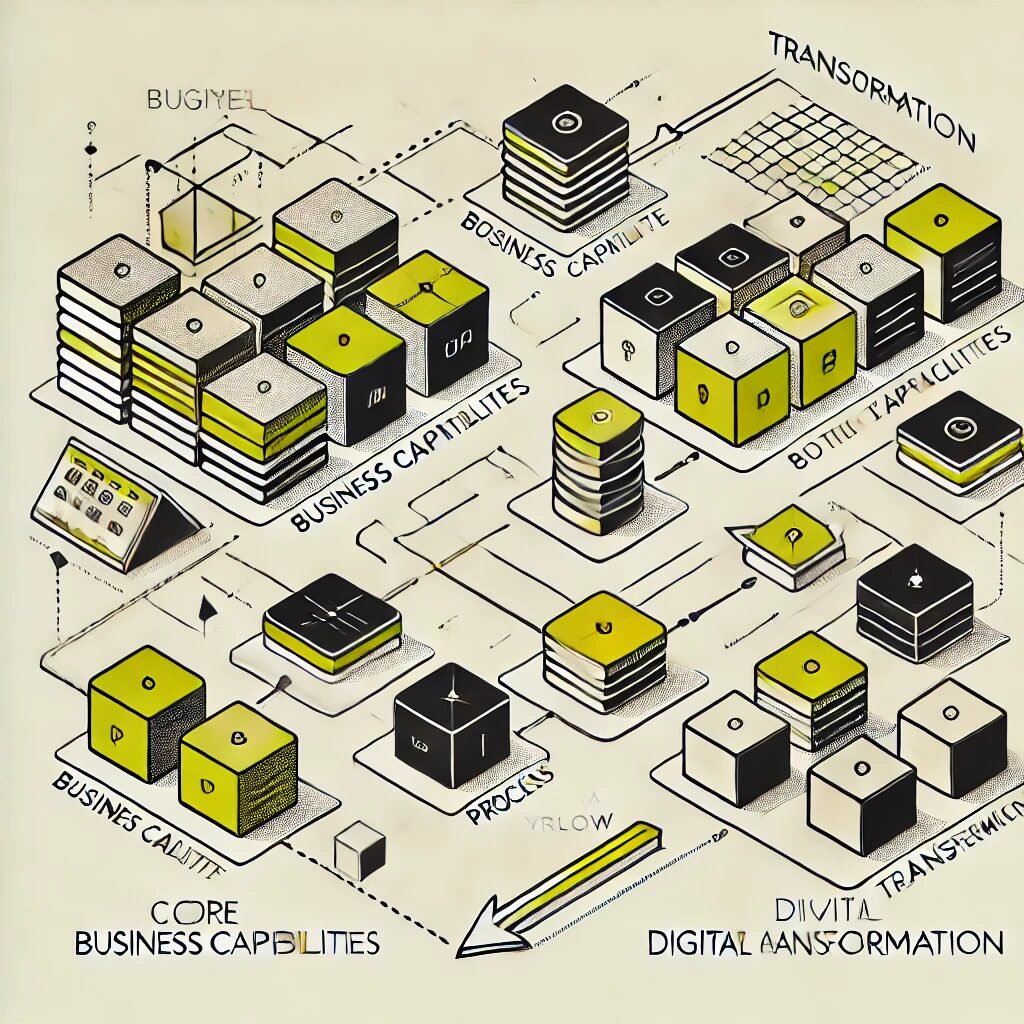
Enterprise Architecture as the Foundation for Digital Transformation in Medical Device Manufacturing. Build the architecture today that delivers the digital innovations of tomorrow.
Medical device manufacturers stand at a critical inflection point where regulatory demands, market pressures, and technological possibilities converge. The industry that once focused primarily on hardware innovation now must integrate software, connectivity, data analytics, and artificial intelligence while maintaining rigorous safety standards and regulatory compliance. Digital transformation is no longer optional but essential for survival and growth.
Enterprise Architecture (EA) provides the comprehensive framework medical device manufacturers need to navigate this complex digital journey. By creating clarity across business, information, application, and technology domains, EA enables organizations to align transformation initiatives with strategic priorities, ensure regulatory compliance by design, and build the flexible foundation needed for ongoing innovation. Without this architectural foundation, digital initiatives risk becoming fragmented, inefficient, and potentially non-compliant efforts that deliver suboptimal value.
1: The Digital Imperative for Medical Device Manufacturers
Medical device companies face increasing pressure to digitalize their products, services, and operations. This transformation is driven by converging forces that are reshaping the competitive landscape.
- Connected Device Evolution: The shift from standalone devices to connected systems that generate, analyze, and share data creates new opportunities for competitive differentiation and value-based care delivery.
- Regulatory Technology Requirements: Emerging regulations like EU MDR and FDA’s Digital Health initiatives demand more sophisticated approaches to software validation, cybersecurity, and post-market surveillance.
- Data-Driven Decision Making: The expectation that medical device companies will provide evidence of real-world effectiveness drives the need for capabilities to collect, analyze, and leverage clinical and operational data.
- Patient-Centered Innovation: The movement toward personalized medicine and patient engagement requires digital capabilities that enable customization, monitoring, and active participation in care.
- Competitive Disruption: New market entrants from technology sectors are challenging traditional medical device business models with digitally-native approaches to healthcare solutions.
2: Enterprise Architecture: The Foundation for Transformation
Enterprise Architecture provides medical device manufacturers with the structured approach needed to navigate complex digital transformation while maintaining regulatory compliance.
- Strategic Alignment Framework: EA creates the mechanisms to translate strategic objectives into concrete architectural requirements, ensuring digital initiatives deliver meaningful business value.
- Compliance by Design: A mature EA practice embeds regulatory requirements into architectural standards, ensuring that digital solutions maintain compliance with FDA, EU MDR, and other relevant regulations.
- Transformation Roadmapping: EA provides the foundation for creating realistic, sequenced transformation plans that balance quick wins with long-term strategic capabilities.
- Decision Optimization: Architectural governance enables more effective technology investment decisions by evaluating options against consistent standards and strategic priorities.
- Complexity Management: EA helps organizations manage the inherent complexity of medical device operations by creating visibility, standards, and patterns that simplify the digital landscape.
3: The Architecture Domains Critical for Medical Device Transformation
A comprehensive Enterprise Architecture for medical device manufacturers encompasses four interconnected domains that collectively enable successful digital transformation.
- Business Architecture: This domain creates clarity about capabilities, value streams, and organizational structures required to deliver on the medical device company’s mission and strategy.
- Information Architecture: This critical domain defines how data is created, stored, protected, and leveraged across the product lifecycle, ensuring both regulatory compliance and strategic value generation.
- Application Architecture: This domain provides the blueprint for software applications and integrations that enable business capabilities while meeting performance, security, and compliance requirements.
- Technology Architecture: This foundation establishes standards for infrastructure, networks, platforms, and security that support reliable, scalable, and compliant digital operations.
- Security Architecture: This specialized domain, increasingly important for connected medical devices, establishes controls that protect patient data, intellectual property, and operational integrity.
4: Business Architecture: Aligning Strategy with Digital Capabilities
Business Architecture creates the link between strategic objectives and the capabilities, processes, and organizational structures required for successful digital transformation.
- Capability Mapping: Documenting and assessing the organization’s capabilities reveals where digital enhancement can deliver the greatest strategic value and regulatory compliance.
- Value Stream Optimization: Mapping end-to-end value creation from R&D through commercialization and support identifies opportunities to apply digital technologies for accelerated innovation and market response.
- Organizational Alignment: Evaluating how well organizational structures support digital capabilities helps identify where new roles, skills, or reporting relationships may be required.
- Metrics Framework Development: Establishing outcome-based metrics ensures digital investments are evaluated based on their contribution to strategic objectives rather than technical specifications alone.
- Digital Operating Model Design: Creating the blueprint for how digital and traditional functions will work together enables more effective transformation execution and sustainable operations.
Did You Know
- According to a 2024 industry study, medical device manufacturers with mature Enterprise Architecture practices achieve 34% higher returns on their digital investments compared to those with ad hoc approaches to architecture.
5: Information Architecture: The Data Foundation for Digital Innovation
Information Architecture is particularly critical for medical device manufacturers navigating digital transformation, as data becomes both a strategic asset and a compliance obligation.
- Master Data Governance: Establishing consistent definitions and ownership for critical data domains like products, components, customers, and regulatory requirements simplifies compliance and enables analytics.
- Regulatory Documentation Architecture: Designing information structures that support Design History Files, Technical Documentation, and other regulatory records ensures both compliance and operational efficiency.
- Real-World Data Strategy: Developing frameworks for collecting, managing, and analyzing data from devices in use creates opportunities for product improvement and value-based commercial models.
- Data Quality Management: Implementing systematic approaches to data quality, particularly for regulated information, reduces compliance risk while increasing the value of analytics initiatives.
- Information Lifecycle Management: Designing processes for retaining, archiving, and disposing of information in accordance with regulatory requirements avoids both compliance issues and unnecessary storage costs.
6: Application Architecture: Building the Digital Ecosystem
Application Architecture defines how software systems will work together to support capabilities while meeting performance, security, and compliance requirements.
- Application Portfolio Rationalization: Evaluating existing applications against future capability needs identifies consolidation opportunities and modernization priorities.
- Integration Architecture Design: Developing patterns for connecting applications within and beyond organizational boundaries enables seamless information flow while maintaining appropriate controls.
- Software as a Medical Device Governance: Creating specific architectural standards for SaMD ensures these applications meet both technical requirements and regulatory obligations.
- Cloud Strategy Development: Establishing clear principles for when and how cloud platforms can be used balances innovation opportunities with compliance and security requirements.
- Development Standards Creation: Implementing consistent development practices, particularly for validated systems, improves quality while reducing the overhead of maintaining regulated applications.
7: Technology Architecture: The Foundation for Digital Reliability
Technology Architecture establishes the infrastructure, networks, and platforms that enable reliable, secure, and compliant digital operations.
- Infrastructure Standardization: Developing consistent approaches to infrastructure deployment reduces complexity while ensuring performance and security requirements are met.
- Network Security Design: Creating network architectures that appropriately segment and protect different types of systems and data is critical for both cybersecurity and regulatory compliance.
- Platform Strategy Development: Establishing enterprise platforms for common functions like IoT, analytics, and content management prevents proliferation of redundant solutions.
- Technology Lifecycle Management: Implementing systematic approaches to technology refresh ensures critical systems remain supported and secure throughout their operational life.
- Disaster Recovery Architecture: Designing resilient technology architectures with appropriate redundancy and recovery capabilities protects both operations and compliance status.
8: Security Architecture: Protecting Patients, Data, and Operations
Security Architecture has become a critical concern for medical device manufacturers as products become connected and operations digitalize.
- Product Security Framework: Developing security requirements and testing approaches for connected medical devices ensures patient safety and regulatory compliance.
- Identity and Access Management: Implementing consistent approaches to authentication and authorization protects sensitive information while enabling appropriate access.
- Data Protection Architecture: Designing encryption, anonymization, and access control mechanisms safeguards patient information and intellectual property across the enterprise.
- Security Monitoring Strategy: Creating capabilities to detect and respond to security incidents protects operations and enables compliance with breach notification requirements.
- Supply Chain Security Management: Establishing controls for managing security risks from suppliers and partners is increasingly critical as medical device ecosystems become more interconnected.
9: Regulatory Compliance Through Architecture
Enterprise Architecture provides medical device manufacturers with systematic approaches to meeting regulatory requirements while enabling digital innovation.
- Regulatory Requirement Mapping: Documenting how specific regulations translate into architectural requirements ensures compliance is built into digital solutions from the beginning.
- Change Impact Analysis: Creating the ability to quickly assess how regulatory changes affect existing architecture components enables more proactive compliance management.
- Validation Architecture: Developing consistent approaches to software validation reduces the burden of maintaining compliance while enabling more frequent innovation cycles.
- Traceability Implementation: Designing mechanisms to maintain traceability between requirements, design elements, tests, and production builds simplifies regulatory submissions and audits.
- Documentation Generation: Creating architectures that automatically generate or update regulatory documentation reduces compliance overhead and improves documentation accuracy.
Did You Know
- Organizations with well-developed architectural governance experience 47% fewer regulatory findings related to their digital systems and connected devices, significantly reducing remediation costs and market delays.
10: Architecture for Digital Innovation Acceleration
Enterprise Architecture can significantly accelerate innovation cycles when designed to enable rapid, compliant development of new digital capabilities.
- Composable Architecture Design: Creating modular, reusable components with well-defined interfaces enables faster assembly of new digital solutions while maintaining appropriate controls.
- Digital Thread Implementation: Establishing unbroken digital connections across the product lifecycle accelerates innovation by improving information flow between functions.
- Innovation Sandbox Definition: Designing controlled environments for experimenting with new technologies reduces compliance risk while encouraging creative problem-solving.
- Agile Governance Framework: Developing governance approaches that maintain compliance while supporting iterative development accelerates time-to-market for digital innovations.
- Architectural Runway Creation: Proactively building technical foundations for anticipated innovation needs removes barriers to rapid implementation when opportunities arise.
11: Architecture-Driven Digital Transformation Roadmapping
Enterprise Architecture provides the foundation for creating realistic, impactful transformation roadmaps that balance quick wins with long-term strategic capabilities.
- Current State Assessment: Evaluating existing architectural maturity across domains identifies both constraints that must be addressed and assets that can be leveraged.
- Capability Prioritization: Analyzing capability gaps against strategic objectives highlights the highest-value targets for digital enhancement or transformation.
- Dependency Mapping: Documenting how architectural components depend on each other ensures transformation initiatives are sequenced appropriately to avoid technical roadblocks.
- Initiative Definition: Translating architectural requirements into specific projects and programs creates clarity about what needs to be done, by whom, and in what timeframe.
- Value Realization Planning: Establishing clear metrics and measurement approaches for transformation outcomes ensures investments deliver expected business benefits.
12: Building an Effective EA Practice for Medical Device Manufacturers
Creating a successful Enterprise Architecture function requires the right structure, skills, and connections to the broader organization.
- Executive Sponsorship Securing: Gaining C-level support for Enterprise Architecture as a strategic function is essential for ensuring appropriate authority and resource allocation.
- Team Structure Design: Developing an EA team structure that balances domain expertise, industry knowledge, and connection to operational units enables more effective architecture development.
- Governance Implementation: Establishing mechanisms for reviewing and approving architectural decisions ensures standards are maintained while enabling appropriate flexibility.
- Skill Development Planning: Creating development paths for architects that combine technical depth, business understanding, and regulatory knowledge builds a more effective EA function.
- Value Demonstration Approach: Implementing consistent methods for measuring and communicating the value of architecture work builds organizational support for EA initiatives.
13: Enterprise Architecture for Mergers & Acquisitions
As consolidation continues in the medical device industry, Enterprise Architecture provides critical support for effective integration and value realization.
- Due Diligence Support: Using architectural assessment frameworks during acquisition evaluation provides deeper insight into technical debt, integration challenges, and digital capability gaps.
- Integration Planning: Developing target architecture for combined organizations creates clarity about which systems will be retained, consolidated, or replaced.
- Day-One Requirement Definition: Identifying the minimal architectural components that must function immediately after transaction close ensures business continuity during integration.
- Synergy Opportunity Identification: Analyzing architectural overlap between organizations reveals potential for cost reduction through consolidation of redundant systems and capabilities.
- Cultural Integration Enablement: Designing collaborative platforms and shared environments helps bridge cultural and operational differences between merging organizations.
14: Navigating Cloud Transformation for Medical Device Manufacturers
Cloud adoption presents both opportunities and compliance challenges for medical device manufacturers, requiring thoughtful architectural guidance.
- Cloud Suitability Assessment: Evaluating different workloads against regulatory requirements, security needs, and performance characteristics identifies appropriate cloud migration candidates.
- Multi-Cloud Strategy Development: Creating a framework for selecting and managing multiple cloud providers prevents both vendor lock-in and uncontrolled proliferation of cloud platforms.
- Data Sovereignty Architecture: Designing approaches to manage data location, governance, and protection requirements across global operations ensures compliance with varied regional regulations.
- Cloud Security Framework: Implementing consistent security controls across cloud services protects sensitive information and maintains regulatory compliance in distributed environments.
- SaaS Governance Establishment: Developing standards for evaluating, implementing, and managing Software-as-a-Service solutions prevents shadow IT while enabling business agility.
15: Future-Proofing Medical Device Architecture
Enterprise Architecture helps medical device manufacturers prepare for emerging technologies and evolving business models that will shape the industry’s future.
- AI Readiness Assessment: Evaluating architectural foundations for artificial intelligence adoption, including data quality, processing capacity, and ethical frameworks, prepares organizations for AI-enabled innovation.
- Digital Twin Framework: Developing the architecture to support digital representations of physical devices enables advanced simulation, predictive maintenance, and personalized solutions.
- Ecosystem Integration Preparation: Creating architectural patterns for securely connecting with healthcare systems, patient applications, and partner solutions supports expansion into platform business models.
- Regulatory Horizon Scanning: Establishing mechanisms to monitor emerging regulations and standards allows proactive architectural adaptation rather than reactive compliance.
- Organizational Change Readiness: Building change management capabilities into the EA function helps the organization adapt to increasingly rapid technological and market evolution.
Did You Know
- Medical device companies that establish architecture-driven digital foundations bring new connected devices to market 28% faster than competitors while maintaining equivalent quality and compliance standards.
Takeaway
Enterprise Architecture provides medical device manufacturers with the essential foundation for successful digital transformation in a highly regulated environment. By creating clarity across business, information, application, and technology domains, EA enables organizations to align digital initiatives with strategic priorities, ensure regulatory compliance by design, and build the flexible foundation needed for ongoing innovation. As the industry continues to evolve toward more connected, software-intensive, and data-driven solutions, the architectural discipline becomes increasingly critical for maintaining both competitive advantage and regulatory compliance. Medical device manufacturers that invest in mature EA practices position themselves to navigate digital transformation more effectively, accelerate innovation cycles, and deliver greater value to patients, providers, and shareholders.
Next Steps
- Assess Your Architectural Maturity: Evaluate your current Enterprise Architecture capabilities against industry benchmarks to identify priority improvement areas across business, information, application, and technology domains.
- Align Architecture with Strategy: Ensure your Enterprise Architecture function has clear visibility into strategic priorities and is positioned to translate these into architectural requirements and principles.
- Develop Your Regulatory Architecture: Create explicit architectural standards and patterns that address key regulatory requirements like cybersecurity, software validation, and design controls.
- Build Your Digital Foundation: Identify and implement the core architectural components needed to support your digital transformation, focusing on platforms that enable multiple business capabilities.
- Establish Governance Mechanisms: Implement cross-functional governance processes that ensure architectural decisions support both innovation objectives and regulatory compliance requirements.



